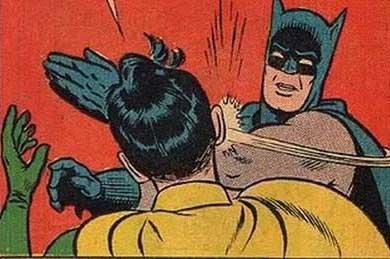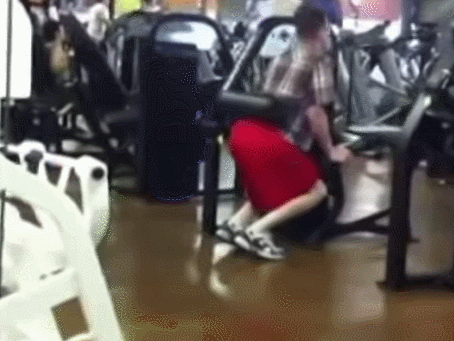1) Stress is stress. And there are many outputs that can occur in response to stress. Too often we get stuck obsessing over just one of the outputs – PAIN. As movement professionals we should focus on the output that we’re the most proficient at – MOVEMENT. If you disagree, Zac Cupples will convince you in this phenomenal article. “Assessing movement may be the simplest way to assess an individual’s stress status.”
2) Decreased hamstring strength increases ACL loading during sidestep cutting.
3) “If your tongue is on the roof of your mouth, you are connecting palate, pharynx, hyoid, jaw, and skull. You are stabilizing your airway, so you can breathe, while anchoring your TMJ so it doesn’t deviate. Now, your body is more balanced and can better ambulate.” –Kathy Dooley
4) Your butt can stop you from peeing?
5) Aleks Salkin has some great advice on how to pass your SFG Snatch test.
6) “Football players who had greater cervical stiffness and an ability to decrease the displacement of their head following perturbation were less likely to sustain a moderate and severe head impacts.“
7) Some good advice for cross-training when injured.
8) “Sure posture does not matter when studied, but it’s the introduction of variability that resets the nervous system, not always something as simple or mechanical as postural correction.” -Erson Religioso
9) Regarding exercise regressions and progressions – “a continuum is an environment that we create.” – Gray Cook
10) “Rather than friction causing irritation of the ITB, it is now thought that compression of the associated fat layer may be the culprit.” The best ITB article I’ve read in a long time, by John Foster.
11) When you bash other approaches it not only confirms your insecurity as a clinician, but it also…
12) “Acupuncture points have a higher density of micro-vessels and contain a large amount of involuted microvascular structures. The non-acupuncture points did not exhibit these properties.”
13) A great 5 minute TED-Ed video to help explain pain to your patients (via @ShinePTyoga)
14) Here’s a nice review of sensory processing in the brain.
15) Erson’s Friday Fives
5 Ways to Increase Ankle DF Without the Talocrual Joint – 1) Calcaneus 2) Great Toe 3) Tibial IR 4) Sidegliding in Standing 5) IASTM to Anterior Calcaneus
5 Ways to Ensure Patient Compliance – 1) Use the Edge of Ability 2) Make it Pain Free 3) Simplify the HEP 4) Encourage Communications 5) Connect with Your Patient
5 More Articles That Have Influenced My Practice
16) The squat is a very complex movement. There are many variables that can affect the movement pattern. A common mistake is to blame a complex output on a single input. The butt wink (posterior pelvic tilt/lumbar flexion at the bottom of a squat) has many possible causes. Some have blamed it on hamstring length, osseous morphology, ankle dorsiflexion limitations, anterior tibialis weakness, hip flexor weakness, eccentric quad strength, decreased anterior core, glute weakness, lumbar extensor weakness, decreased thoracic mobility, limited hip internal rotation, local motor control dysfunction, or a poor global motor program. Julie Wiebe adds another variable to this list – Pelvic Floor Dysfunction. “Squeezing one part of the system does not create a balance.” The more you know, the better you can assess.
17) This is my go to exercise for shoulder patients who have progressed past supine KB holds and quadruped progressions.
18) “Generally speaking, slow stretch activates the Ia afferent loop which causes a physiological contraction of the muscle (this is one of the reasons you do not want to do slow, steady stretch on a muscle in spasm).” -Gait Guys
19) “Our results show that an increase in the amplitude of force produced by one hand corresponded with a decrease in pain perception in the other hand.”
20) Here’s an article on shoulder flexion/extension muscle patterns. “During extension subscapularis and latissimus dorsi were activated at higher levels than during flexion; during flexion, supraspinatus, infraspinatus, deltoid, trapezius, and serratus anterior were more highly activated than during extension. In addition, the pattern of activity in each muscle did not vary with load.”
21) Here are a ton of great interviews from CinemaSays.
22) Dysregulated Supersystems, Cognition, Phase Shifts, Attractors, Feedback Loops, and more. This is the best article you’ll read on chronic pain from Todd Hargrove.
23) Want your patients to cooperate? Try telling a story – “character-driven stories do consistently cause oxytocin synthesis”. “Oxytocin is produced when we are trusted or shown a kindness, and it motivates cooperation with others. “
24) Here’s my opinion on Crossfit and the 2 Mistakes that can prevent injuries.
25) David Butler shares an example of how to treat “shin splints” with neurodynamics and pain education.
26) Patrick Ward tells you what kind of manual therapy you should choose.
27) An interesting read on muscle spindles.
28) Bret Contreras sums up everything you want to know about EMG studies in this article.
29) “Flexion allows for movement variability, which is desirable in the human system. Variable movement reduces threat perception. However, system flexion leads to increased instability and the risk of falling forward. To combat this risk, impingement may occur by compensatory extension.” -Zac Cupples
30) Loss of anterior core control is an epidemic. We see it in all different patient populations. Eric Cressey goes over 6 reasons why you need to focus on the anterior core.
31) If you’re doing box squats for performance training, make sure you don’t sit on the box.
32) “In fact, MRI findings will increase the fear of their condition, which in turn increases their awareness of their pain”
33) “What “master” clinicians often have is not necessarily better hands, or psychomotor competence, but recognition of Clinical Practice Patterns.”-Erson
34) Get to know the influence of the one, the only, the Great Toe. “What happens is that toe stays flexed, the first met head collapses, the arch falls and forces the foot into early pronation which locks up dorsiflexion.”
35) It’s not just physical movement that determines return to sport. “Psychological readiness to return to sport and recreation was the factor most strongly associated with returning to the preinjury activity.”
36) Here’s another gait assessment rabbit hole from the Gait Guys.
37) Manual therapy is really brain therapy.
38) Corey Hart was right. You should wear your sunglasses (blue blocker) at night if you’re using blue light devices. It’ll improve your health via your Circadian cycle.
39) People You Should Know – Robin McKenzie was a pioneer who helped change physical therapy from a passive modality directed by MD’s to an autonomous profession that utilizes active assessment and intervention. The story behind the origin approach, Mechanical Diagnosis and Therapy (MDT), is worth a listen. He was one of the first physical therapists to abandon the pathoanatomical biased model in preference for a movement based system. His approach has changed the way medical professionals address back pain. It provides physical therapists an avenue with which they can empower patients to treat their own pain.
40) Top 3 Tweets of the Month
-
Tom Myers
@myers_info – Genes are the canvas ; environment is the paint -
Scott Belsky
@scottbelsky – Thinking: One of the most important things experience gives you is the confidence to make decisions without certainty. -
Nick Winkelman
@NickWinkelman – “Ask your clients how many pillows they need to sleep. If it is more than one they have a mobility problem.” -Dan John#AZNSCA#Simple
41) Another way to treat your own back




